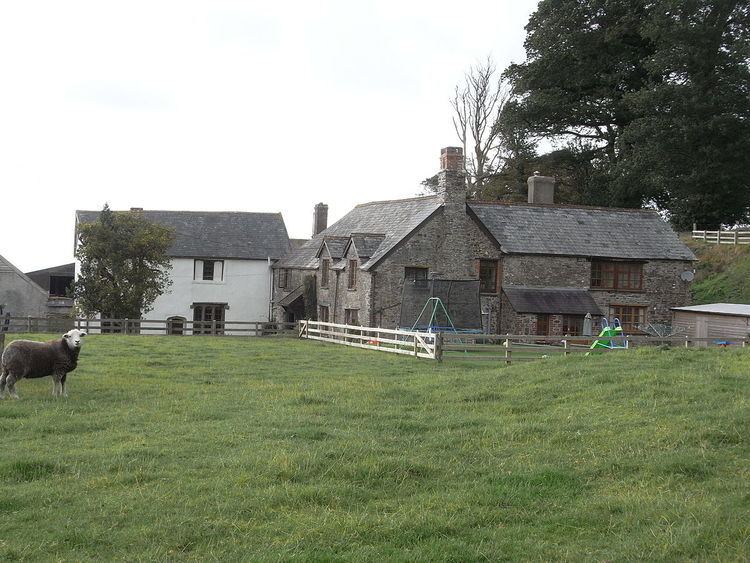 | ||
The estate of Acland (alias Accelana, Akeland etc.) in the parish of Landkey, near Barnstaple in North Devon, England, was from 1155 the earliest known seat of the influential and wealthy family of Acland, to which it gave the surname de Acland. It is situated about 3/4 mile north-east of the village of Landkey, from which it is now cut off by the busy A361 North Devon Link Road.
Contents
The estate remained the seat of the Aclands until the 17th century, after which it was let to tenants until sold in 1945.
Description of house
Acland Barton and Chapel were classed as a Grade I listed building in 1965. The house was completely rebuilt in the 15th century, and included its own private domestic chapel, licensed by the Bishop of Exeter. The date 1591 survives carved onto the wooden porch, and represents the modernisation and rebuilding of the house at that date involving the insertion into the great hall of a ceiling with room above, thus lowering the height of the house's principal room. This work was done by Hugh Acland (1543–1622), who lived at Acland his whole life.
The surviving structure is the main range and west wing of the Tudor house. The hall's wooden screen and screens passage survives. The windows of the main range are later alterations.
Descent
The estate is likely originally to have been named after its first Saxon holder named Acca. The estate was held under the feudal tenure of socage from the manor of Bishop's Tawton (in which was situated the parish of Landkey), one of the possessions of the See of Exeter. The house contained its own domestic chapel, licensed by the Bishop of Exeter.
The Devon historian Risdon (died 1640) stated regarding the parish of Landkey:
In this parish is Acland, pleasantly situated against the south, in the side of a hill, which hath given name to its ancient dwellers, who have continued in that place from king Henry the second unto this present time. Of which lineage, five of the first were called Baldwin...
In the opinion of Hoskins (1981), the early and repeated use of the Flemish first name of Baldwin, suggests that the Acland family probably migrated to England from Flanders soon after the Norman Conquest of 1066. The family's historian Anne Acland (Lady Acland, wife of Sir Richard Thomas Dyke Acland, 15th Baronet (1906–1990)) stated (1981): "However the name is spelt, there is no branch of the enormous family which does not stem from the tree which first took root at Acland Barton". By the end of the 12th century the Aclands of Acland held an estate of about 400 acres of land.
The descent of the estate of Acland as reported by John Acland in the Heraldic Visitation (1531, 1564 or 1620) of Devon was as follows:
"John Akland of Akland served in France anno 9 of King Rich 2 (i.e. 1385) which appeareth by his deede made unto c'tain feoffees dated the same year, expressinge a condition for moneys to be raised for payment for his redempcion yf it happened that hee were taken prisoner, and a frustrating of the deed upon his retorne"
After this, Acland was retained in the family's ownership and let to tenants, whereupon it became known as Acland Barton. The house served for many generations as a farmhouse, let to tenants by the Acland family, until it was sold in 1945 to the tenant by Sir Richard Thomas Dyke Acland, 15th Baronet (1906–1990).
For the continuing descent of the Acland family see Acland Baronets and Killerton. By the 19th century the family possessed a huge estate in the West Country of almost 40,000 acres, and in the late 20th century it was probably the oldest surviving landed family in Devon.
Description in 1726
The "Farme of Akelane" is the first entry in the 261 pages which comprise the 1726 survey made of the Acland estates by Thomas Nott, steward to Sir Hugh Acland, 6th Baronet (1696–1728). It was listed under the heading "Landkey Parish" and was recorded at an annual value of £79, having been leased to Edward Ratclyffe and part to Gregory Davy. The tenant was Samuel Wreford. A note stated:
To this farm there belongs an isle (i.e. aisle) in the parish church of Landkey where many of the ancestors (of) Sr Hugh Acland ly interred, this isle is repaired by the owner of the farme. Notwithstanding it is charged with church rates which being thought unreasonable it was contested at law but given for the parish they proving the ancient usage of the same so that I suppose the isle was built by some of the family for their own conveniency and the rates still continued as before but whatever seat there was before in the church it is now lost.
This appears to confirm that the Acland family built the south transept of St Paul's Church, Landkey, in which is situated the Acland Chapel, in which the only surviving monument is that of Arthur Acland (died 1610) of Acland and in which was formerly situated the Acland family pew. This is not to be confused with the private chapel which existed within the former "mansion" of Acland, licensed by the Bishop of Exeter.
Map of 1758
The survey made in 1758 by John Bowring of the Acland family's estates includes an elaborate map (no. XVIII) showing "Riverton Manor, Acland Barton, Westcott, East Bathey, West Bathey and a cottage at Newland in the parish of Landkey". It is decorated in the Rococo style with acanthus, field plants, a lamb and winged putto and with scrolls and cornucopia of fruit and flowers.
